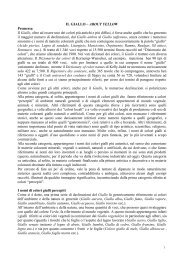Bianco e nero e⦠Intervista a Narciso Silvestrini ... - Istituto Del Colore
Bianco e nero e⦠Intervista a Narciso Silvestrini ... - Istituto Del Colore
Bianco e nero e⦠Intervista a Narciso Silvestrini ... - Istituto Del Colore
You also want an ePaper? Increase the reach of your titles
YUMPU automatically turns print PDFs into web optimized ePapers that Google loves.
<strong>Bianco</strong> e <strong>nero</strong> e… <strong>Intervista</strong> a <strong>Narciso</strong> <strong>Silvestrini</strong> / Black and white and... Interview with <strong>Narciso</strong> <strong>Silvestrini</strong><br />
“Qui è il problema:<br />
non bianco; non<br />
bianchi; ma bianco<br />
generalizzato,<br />
perché il bianco<br />
generalizzato<br />
- la bianchezza -<br />
è astratto, isolato<br />
e aperto alla<br />
contaminazione<br />
con termini come<br />
‘puro’.<br />
<strong>Bianco</strong> puro:<br />
questo è<br />
certamente<br />
un problema<br />
occidentale, e<br />
non c’è modo di<br />
liberarsene”.<br />
“Here is the<br />
problem: not<br />
white; not whites;<br />
but generalized<br />
white, because the<br />
generalized white<br />
- the whiteness -<br />
is abstract,<br />
isolated and open<br />
to contamination<br />
by terms like<br />
‘pure’.<br />
Pure white: this<br />
is certainly a<br />
western problem,<br />
and there is no<br />
way to get rid<br />
of it”.<br />
David Batchelor, Cromofobia. Storia della paura<br />
del colore, Mondadori, 2001, p. 6<br />
questo avviene solo se lo schermo di proiezione era già bianco perché,<br />
se fosse stato, ad esempio, verde, la zona di sovrapposizione dei tre<br />
primari sarebbe apparsa verde; se gialla, gialla; se nera, nera e così via.<br />
Solo convenzionalmente, in fisica, si parla di “luce bianca”; luce (radiazione)<br />
che, invisibile in sé, consente poi, all’osservatore la miglior<br />
discriminazione cromatica.<br />
In verità, l’effettivo bianco di sintesi è quello della “sintesi ottica”; è quello<br />
che risulta dallo schermo video quando, a partire dal <strong>nero</strong>, dallo “spento”,<br />
vi siano attivati, contemporaneamente, tutti e tre i primari RGB.<br />
Parlando di bianco e <strong>nero</strong> non si può fare a meno di chiedere... ma<br />
sono davvero dei colori?<br />
Si e no. Se il colore è caratterizzato dai tre parametri percettivi tinta,<br />
chiarezza, saturazione, allora anche il bianco, il <strong>nero</strong> e gli interposti<br />
grigi possono essere chiamati colori; sono colori ai quali manca la componente<br />
tinta; sono colori cosiddetti “acromatici” per distinguerli dalle<br />
tinte denominate, nel sistema NCS, colori “cromatici”.<br />
Se invece per tonalità cromatica si intende “l’equivalente psicosensoriale<br />
di una determinata lunghezza d’onda dominante” allora il bianco,<br />
il <strong>nero</strong> ed i grigi, non avendo una loro corrispondente lunghezza d’onda<br />
elettromagnetica, non possono essere denominati colori. Ma in questo<br />
caso neanche i magenta o porpora sarebbero colori dal momento che<br />
non rispondono ad alcuna loro specifica lunghezza d’onda.<br />
Se poi ogni tonalità la si può ottenere per opportuna mescolanza di tre<br />
tinte primarie, allora anche i porpora sono tinte e sono colori: ancora il<br />
porpora, il bianco, i grigi, il <strong>nero</strong>, pur risultando da operazioni differenti:<br />
chi per addizione, chi per attenuazione, chi per sottrazione.<br />
In altre parole, tutto dipende da cosa si intende per colore, per tinta,<br />
per chiarezza.<br />
Nella nostra cultura si è andata sviluppando quella che Manlio Brusatin<br />
definisce una sorta di cultura intellettuale e ideologica del<br />
bianco e <strong>nero</strong> rispetto alla superficialità del colore. Una sorta di “cromofobia<br />
diffusa che è diventata una trincea estetica, perfino letteraria,<br />
davanti all’aggressione del colore...” 1 .<br />
Nessuna tinta può essere tradotta in un’altra tinta a lei equivalente.<br />
Ogni tinta, invece, può essere convertita in un grigio a lei corrispondente<br />
per chiarezza; biunivocamente, vale anche il contrario.<br />
Nessuna tinta però può essere equiparata, sempre per chiarezza, al<br />
bianco e al <strong>nero</strong>.<br />
Dunque il bianco e il <strong>nero</strong> sono “oltre” e sono “altro”.<br />
Quasi a riprova, è da notare che, quando siano nella loro pienezza, le<br />
tinte sono dette “sature” (verde saturo, blu saturo, etc.) mentre al bianco<br />
e al <strong>nero</strong> è riservato il termine “assoluto” (bianco assoluto, <strong>nero</strong> assoluto).<br />
In quanto assoluti, il bianco e il <strong>nero</strong> sono delle invarianti per cui prevalgono<br />
sulle variazioni contingenti delle tinte e, più estesamente di queste,<br />
possono avvicinare l’immanenza e la trascendenza fino a divenire<br />
e porsi come veri e propri assunti “intellettuali e ideologici”.<br />
Spesso nel corso delle tue lezioni ti si sente dire che in fondo preferisci<br />
insegnare il colore in bianco e <strong>nero</strong>...<br />
Io non sono né un artista né un color designer; l’aspetto del colore che<br />
lights, projected and overlapped among each other on a screen, produces<br />
white. But this will happen only if the projection screen already<br />
was white because if it had, for example, been green, the overlap area<br />
of the three primary colours would have appeared green, if yellow, yellow,<br />
and if black, black and so on. Only conventionally, in physics, we<br />
speak of “white light”, light (radiation) that, invisible in itself, then allows<br />
to the observer the best colour discrimination.<br />
In truth, the actual white colour of synthesis is the one of “optical<br />
synthesis”; it is the one resulting from the screen video when, starting<br />
from black, from the “off” state, all three RGB primary colours are<br />
simultaneously activated.<br />
Speaking of black and white one can not help but ask ... but are they<br />
really colours?<br />
Yes and no. If the colour is characterized by the three perceptual parameters,<br />
hue, lightness, saturation, then also white, black and intermediate<br />
grey shades may be called colours; they are colours who lack<br />
the hue component; they are so-called “achromatic” colours to distinguish<br />
them by the hues denominated, in the NCS system, “chromatic”<br />
colours.<br />
If we are instead meaning with colour tone “the psychosensory equivalent<br />
of a given dominant wavelength” then white, black and grey<br />
shades, not having their own corresponding length of electromagnetic<br />
wave, can not be named colours. But in this case not even magenta or<br />
purple would be colours as they do not respond to any specific wavelength.<br />
Then if each shade could be obtained through an appropriate mixture<br />
of three primary hues, then even purple would be hues and would be<br />
colours: still purple, white, grey shades, black, despite resulting from<br />
different operations: some from addition, others for attenuation, some<br />
for subtraction.<br />
In other words, everything depends on what you mean by colour, hue,<br />
and lightness.<br />
In our culture something that Manlio Brusatin defines a sort of intellectual<br />
and ideological culture of black and white versus the superficiality<br />
of colour has been developing. A sort of “widespread chromo<br />
phobia that has become an aesthetic trench, even literary, towards<br />
the aggression of colour...” 1 .<br />
No hue can be translated into another equivalent hue. Each hue, instead,<br />
can be converted into a correspondent, for lightness, grey; in a<br />
one-to-one way, it applies also to the opposite.<br />
However no hue can be equated, again for lightness, with white and<br />
black.<br />
So the white and black are “beyond” and “other.”<br />
Almost as proof, we note that when they are in their fullness, hues<br />
are called “saturated” (saturated green, saturated blue, etc.), while to<br />
white and black we reserve the term “absolute” (absolute white, absolute<br />
black).<br />
In absolute terms, white and black are invariants which take precedence<br />
over the contingent variations of hues and larger than these last<br />
ones, they can approach immanence and transcendence to become<br />
and act as real “intellectual and ideological” assumptions.<br />
COLORE 13












